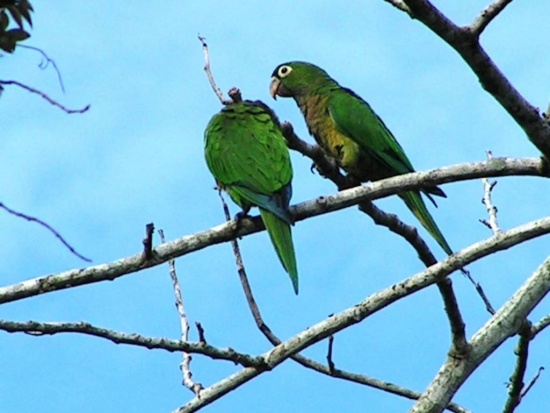- Aratinga nana
Identification
Photographed: Tortuguero NP, Costa Rica.
These parakeets are very colorful birds. They are green on their head, back, and tail and their throat and upper breast area are olive, hence the name olive-throated parakeets. Their green coloration serves as camouflage and allows them to move through the rainforest without being noticed. Their eyes are orange and the bare skin around the eye is a cream color. Lower on the body they are more olive, and their feet are grey. The younger birds tend to have dark irises. They are readily distinguished from other Jamaican parrots by their smaller size, pointed tail, slender body, and rapid flight. Olive-throated parakeets have bills which are large, hard, and curved downward. On average, they are usually 30 centimeters long and they have a wingspan of 60 centimeters.
Distribution
Olive-throated parakeets are found from Jamaica to the southern tip of Central America. They can live in elevations as high as 700 meters and are primarily found in Jamaica but can also be found in St. Thomas, the Dominican Republic, Costa Rica, Mexico and Central America. They are common residents on the mainland of Belize and they are regular winter visitors to Ambergris Caye and Caye Caulker.
Taxonomy
Habitat
Behaviour
These birds announce themselves with their noisy, shrieking chatter as they fly in tight, fast-moving little flocks, dive-bombing into trees that are a bit higher than the rest. Just as suddenly, their screeching will stop and they sit still like little statues, looking around, until slowly they begin moving. Before long they make a circus of twig-climbing and, more than anything, preening and interact with one another. Unlike most birds where male/ female bonds occur only during the breeding season, and function only in coordinating parental care, Olive-throated parakeets are monogamous. Perennial monogamy, or year-round pair bonding, occurs in at least a dozen avian families, including cockatoos and other parrots. They breed one time during the spring between April and May. At this time they look for nesting sites in termite holes and lay three to five eggs which hatch in 26- 27 days. After hatching, it takes about 50 days until the fledglings are ready for their independence.
Although there is no specific data on the communication behavior of these noisy parakeets, one can infer that they use sound as a primary tool in communicating with one another. Males use the contact call for mating and each bird produces its own unique signature contact call. Parrots also have flight calls which make it possible to exchange information on location of resources like food and shelter.
Olive-throated parakeets feed mostly on fruits and vegetables. They eat buds and fruits of many trees and cultivated crops. Because of their strong bill and muscular tongue they are able to seek out fruits and break seeds that would otherwise be difficult for other animals to crack. They associate in flocks to share information about food; like flight calls and frequent chatter between flying birds and those in fruit trees exchanging information. When feeding, parrots are methodical and slow-moving, using their bills as extra “hands” when searching for ripe fruit.
Many of the plants that the parakeet feeds on have built up chemical and mechanical defenses to ward off any possible herbivores. Parrots, though, have become practically immune to these plant’s defenses. To avoid mechanical barriers, parrots’ bills have evolved the ability to crush the largest seeds and destroy most of the seeds they ingest. To fight the chemical defenses of these plants, they digest clay from riverbanks to detoxify the toxic chemicals in the seed or fruit. Alternatively, they avoid poisoning themselves by eating small amounts of toxic seeds and combining that with a larger amount of harmless seeds, therefore substantially decreasing the potential harm.




